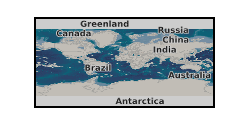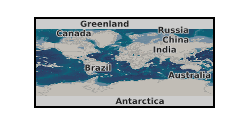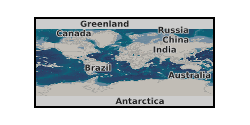Diffusion
Type of resources
Available actions
Topics
Keywords
Contact for the resource
Provided by
Years
Formats
Update frequencies
-

Water concentration as a function of position in silicates from diffusion couple experiments. Data can be used to determine diffusivity of water in the silicate melt. Also numerical model for analysis of dataset and associated user guide.
-

This dataset contains experimental data supporting Vasseur et al. (2023) https://doi.org/10.1111/jace.19120, which investigates the process of glass sintering during dehydration. The experiments were conducted in 2022 at LMU (Munich, Germany) . The samples were synthetic and so were not collected at any given site but were created in the laboratory. For each experiment presented, a sample of glass powder was hydrated by exposing it to a hydrous (H2O) atmosphere at high temperature (600-700 C) for a number of hours. The glass particles were then hydrated, and this fact was checked by looking for a relative mass loss if the same powder was returned to high temperature but under a non-hydrous atmosphere; indeed, mass loss occurred as the water left the particles again. That mass loss was measured and the kinetics of mass loss were analysed. The data demonstrate that there is a quantifiable competition between the rate at which water will move into or out of particles and the rate at which particles will sinter together. This same competition is relevant to volcanic eruptions and has knock-on implications for the evolution of permeability of magmas, which is a prominent area of study for this grant. These data were collected by F. Wadsworth, analysed by J. Vasseur, and the paper was both facilitated by and written by Y. Lavallée and D. B. Dingwell. All authors were responsible for the output of the data.
-

Experimental results used to parameterise and a test a mathematical model of uranium diffusion and reaction in soil. The exeperiments and model are described in Darmovzalova J., Boghi A., Otten W., Eades, L., Roose T. & Kirk G.J.D. (2019) Uranium diffusion and time-dependent adsorption-desorption in soil: a model and experimental testing of the model. Eur. J. Soil Sci., doi: 10.1111/ejss.12814. The research was funded by NERC, Radioactive Waste Management Ltd and the Environment Agency through the Radioactivity and the Environment (RATE) programme (Grant Ref NE/L000288/1, Long-lived Radionuclides in the Surface Environment (LO-RISE)).
-

These data present volume estimates from images (using the solid of revolution method from the cross-sectional area) of clasts expanding during vesiculation at high temperature. The data also contain clast interior volume estimates without the dense rind around the clasts (formed by diffusive outgassing, and estimated through time),l which is is calculated in Matlab. The methods are provided in more detail in Weaver et al., 2022. These data contain sample measurements (surface area), total clast volume calculation (using solid of revolution from clast cross-sectional area), degassed skin area (using imerode in Matlab and the diffusion data provided in the table) and skin volume (solid of revolution from skin surface area), and core surface area and volume from the difference between total clast and skin volumes/skin area. All data are presented in Weaver et al., 2022 (https://doi.org/10.1016/j.jvolgeores.2022.107550), where further details of the methods can also be found. All data were collected and analysed at the University of Liverpool using clasts from Hrafntinnuhryggur, Iceland. The geographical location of the samples collected is of no relevance to this study, as the samples were selected for their physical attributes. All data were collected and analysed throughout 2021 and 2022. Volcanic glass cylinders of different starting sizes were placed in a furnace at high temperature (1006 oC). Two furnaces were used, either a tube furnace with open ends to allow imaging of the sample silhouette, or a box furnace with a sapphire window to allow imaging of the sample as vesiculation takes place. Cross-sectional areas are then converted to volumes using solid of revolution as vesiculation is isotropic. Diffusion modelling is used to quantify the development of the fully degassed rind around the sample and used to estimate the rind volume through imerode in Matlab and solid of revolution. Total clast, core and rind volumes are thus able to be retrieved. As magmas approach the surface of the Earth, volatile saturation in the melt decreases, which results in volatile exsolution in vesicles (vesiculation) and outgassing. The interplay between the amount of vesicles trapped in the melt and those that diffusively outgas from the surface is dependent on the volume to surface area ratio. Understanding the kinetics of outgassing and vesiculation is key to understand pressure build-up in magmatic conduits and effusive-explosive transitions at volcanoes.
-

This is supporting data for the manuscript entitled 'DFENS: Diffusion chronometry using Finite Elements and Nested Sampling' by E. J. F. Mutch, J. Maclennan, O. Shorttle, J. F. Rudge and D. Neave. Preprint here: https://doi.org/10.1002/essoar.10503709.1 Data Set S1. ds01.csv Electron probe microanalysis (EPMA) profile data of olivine crystals used in this study. Standard deviations are averaged values of standard deviations from counting statistics and repeat measurements of secondary standards. Data Set S2. ds02.csv Plagioclase compositional profiles used in this study, including SIMS, EPMA and step scan data. Standard deviations for EPMA analyses are averaged values of standard deviations from counting statistics and repeat measurements of secondary standards. Standard deviations for SIMS and step scan analyses are based on analytical precision of secondary standards. Data Set S3. ds03.csv Angles between the EPMA profile and the main olivine crystallographic axes measured by electron backscatter diffraction (EBSD). 'angle100X' is the angle between the [100] crystallographic axis and the x direction of the EBSD map, 'angle100Y' is the angle between [100] crystallographic axis and the y direction of the EBSD map, and 'angle100Z' is the angle between the [100] crystallographic axis and the z direction in the EBSD map etc. 'angle100P' is the angle between the EPMA profile and the [100] crystallographic axis, 'angle010P' is the angle between the EPMA profile and the [010] crystallographic axis, and 'angle100P' is the angle between the EPMA profile and the [001] crystallographic axis. All angles are in degrees. Data Set S4. ds04.csv Median timescales and 1 sigma errors from the olivine crystals of this study. The +1 sigma (days) is the quantile value calculated at 0.841 (i.e. 0.5 + (0.6826 / 2)). The -1 sigma (days) is therefore the quantile calculated at approximately 0.158 (which is 1 - 0.841). The 2 sigma is basically the same but it is 0.5 + (0.95/2). The value quoted as the +1 sigma (error) is the difference between the upper 1 sigma quantile and the median. Likewise the -1 sigma (error) is the difference between the median and the lower 1 sigma quantile. Data Set S5. ds05.xlsx Median timescales and 1 sigma errors from the plagioclase crystals of this study. Results from each of the parameterisations of the Mg-in-plagioclase diffusion data are included: Faak et al, (2013), Van Orman et al., (2014) and a combined expression. Data Set S6. ds06.xlsx Spreadsheet containing the regression parameters and covariance matrices used in this study and in Mutch et al. (2019). Additional versions of the olivine regressions where the ln fO2 is expressed in Pa have been made for completeness. We recommend using the versions where ln fO2 is expressed in its native form (bars).
-

Primary data, model initial conditions, model results, a compiled database of olivine diffusivity experiments and supplementary tables used in the paper: 'Mutch, E. J. F., Maclennan J., Shorttle, O., Edmonds, M. & Rudge, J. F., (2019), Rapid trans-crustal magma movement under Iceland, Nature Geoscience'. Data_S1 contains electron probe microanalysis (EPMA) profile data of olivine crystals used in this study. This file also includes all of the initial conditions for forsterite content (XFo), Ni and Mn used in the diffusion modelling. Standard deviations are averaged values of standard deviations from counting statistics and repeat measurements of secondary standards. Data_S2 is a compiled database of olivine diffusion experiments used to derive multiple linear regressions for diffusion coefficients and associated covariance matrices. Regressions were only made through [001] data. Data_S3 contains median values for all of the inverted parameters estimated for each crystal profile from the Nested Sampling Bayesian inversion for each type of initial condition and model equation. All of the Monte Carlo realisations for each model are also included in this file. Table_S1 is a supplementary table that contains olivine diffusion equation regression parameters derived and used as part of this study. Table_S2 is a supplementary table that contains covariance matrices for olivine diffusion equations derived in this study. Table_S3 is a supplementary table that contains covariance matrices for aSiO2 (silica activity) dependent olivine diffusion equations derived in this study. Table_S4 is a supplementary table that contains angles between the EPMA profile and the main crystallographic axes in olivine as measured by EBSD. These angles are incorporated into the anisotropy calculation used to determine the apparent diffusivity parallel to the measured profile. angle100P, angle010P and angle001P are the angles between the profile and [100], [010] and [001] respectively. Table_S5 is a supplementary table that contains ,median timescales and 1 sigma errors obtained from the posterior distributions of the Nested Sampling Bayesian inversion conducted on each olivine profile. The results using Al-based initial conditions, constant initial conditions (diffusion only), and aSiO2 based equations using Al-based initial conditions are presented here. The classification of each profile (growth-dominated vs. Al-decoupled) is also shown. See paper (Mutch, E. J. F., Maclennan J., Shorttle, O., Edmonds, M. & Rudge, J. F., (2019), Rapid trans-crustal magma movement under Iceland, Nature Geoscience) for more details.
 NERC Data Catalogue Service
NERC Data Catalogue Service